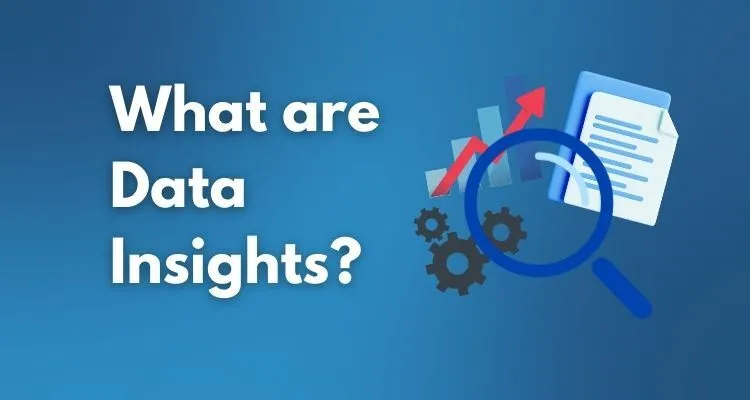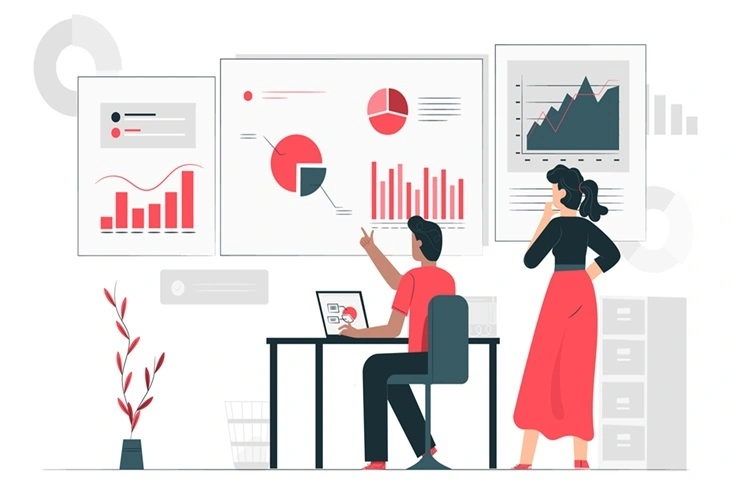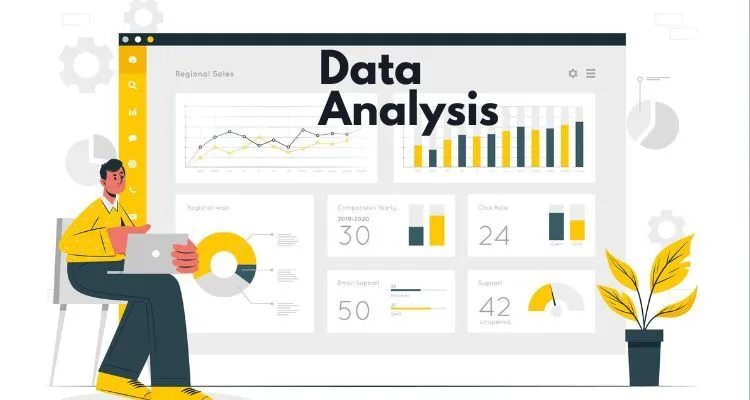- Home
- -Blog
What Are Data Insights and Why They Matter

- 24 May 2024
- Admin
What Are Data Insights?
Understanding data insights has become a critical skill for businesses. Companies generate vast amounts of data daily, and extracting meaningful insights from this data can lead to better decision-making, improved efficiency, and increased profitability. According to a study by McKinsey, data-driven organizations are 23 times more likely to acquire customers, six times as likely to retain them, and 19 times as likely to be profitable. This demonstrates the significant impact that leveraging data insights can have on a business's success.
Definition of Data Insights

Data insights refer to the valuable information extracted from raw data through analysis and interpretation. This process involves identifying patterns, trends, and relationships within the data that can inform strategic decisions. Unlike mere data or statistics, data insights provide a deeper understanding of what the data represents and how it can be used to drive business outcomes. For instance, data insights can reveal customer preferences, operational bottlenecks, or market opportunities that might not be immediately obvious from the raw data alone.
Importance of Understanding Data Insights
Understanding data insights is crucial for several reasons:
- Enhanced Decision-Making: Data insights enable businesses to make informed decisions based on evidence rather than intuition. This can lead to more accurate business and marketing forecasting, better resource allocation, and more effective strategies. For example, a survey by Forrester found that data-driven businesses are 58% more likely to beat their revenue goals than non-data-driven counterparts.
- Competitive Advantage: In a highly competitive market, data insights can provide a significant edge. Companies that can quickly analyze and act on data are better positioned to respond to market changes, customer needs, and emerging trends. According to the MIT Sloan Management Review, companies that emphasize data-driven decision-making have 4% higher productivity and 6% higher profits than their peers.
- Operational Efficiency: By analyzing data, businesses can identify inefficiencies and areas for improvement within their operations. This can lead to cost savings, streamlined processes, and enhanced productivity. For instance, General Electric uses data insights to optimize its manufacturing processes, resulting in millions of dollars in savings annually.
- Customer Understanding: Data insights help businesses understand their customers better, leading to improved customer satisfaction and loyalty. By analyzing customer behavior and preferences, companies can tailor their products and services to meet customer needs more effectively. A study by PwC found that 63% of consumers expect personalization as a standard of service, which can be achieved through data insights.
Understanding Data Insights
Basic Concept: What Data Insights Mean
Data insights refer to the valuable understanding derived from analyzing raw data. This involves identifying patterns, trends, and relationships within the data that can inform strategic decisions. According to Qlik, data insights go beyond simple data collection and statistics by providing a deeper understanding of what the data represents and how it can be applied to drive business outcomes. Lusha also emphasizes that data insights allow businesses to tweak strategies based on specific findings, such as improving email open rates by changing subject lines or increasing customer referrals through personalized gifts.
Differences Between Data Analytics and Insights
It's essential to differentiate between data analytics and insights as each plays a unique role in the information ecosystem:
- Data: This is the raw information collected from various sources such as customer transactions, web traffic, or sensor readings. Businesses often rely on specialized AI data collection tools to gather this raw information efficiently and at scale. However, data alone is not inherently useful until it is processed and analyzed.
- Analytics: Analytics involves examining the raw data to uncover patterns, trends, and relationships. It uses statistical tools and algorithms to interpret the data and generate reports that highlight these findings. Analytics helps transform data into a more understandable format.
- Insights: Insights are the actionable conclusions drawn from analytics. These are the specific valuable understandings that inform decision-making and strategy. Insights explain the significance of the data and suggest practical steps that a business can take based on the analysis.
Types of Data Insights: Descriptive, Predictive, and Prescriptive
Data insights can be categorized into three main types, each serving a different purpose in the analytical process:
- Descriptive Insights: These insights focus on understanding past and current events. They involve summarizing historical data to identify trends and patterns. Descriptive analytics answer questions like "What happened?" and "What is happening now?" For example, a company might use descriptive insights to analyze past sales data and identify which products were the best-sellers.
- Predictive Insights: Predictive insights use historical data and statistical models to forecast future events. This type of analysis answers questions like "What might happen?" By identifying patterns and trends in the data, businesses can make predictions about future outcomes. An example of predictive insights is using data to forecast future sales based on past trends and current market conditions.
- Prescriptive Insights: These insights go a step further by not only predicting future outcomes but also recommending actions to achieve desired results. Prescriptive analytics answer questions like "What should we do?" This type of analysis combines data analytics and business rules to provide actionable recommendations. For instance, a supply chain optimization model might suggest the best way to allocate resources based on predicted demand and production constraints.
Why Data Insights Matter
Enhancing Decision-Making
Data insights significantly improve decision-making processes within organizations. By providing clear, evidence-based information, companies can make more accurate and informed choices. This reduces the reliance on gut feelings or assumptions. According to a survey by Forrester, data-driven businesses are 58% more likely to surpass their revenue goals compared to those that do not utilize data insights. The ability to analyze customer behavior, market trends, and operational performance allows businesses to fine-tune their strategies and make decisions that are aligned with actual data, leading to better outcomes. Leveraging a scraper for Google Maps can enable the extraction of location-based data, offering valuable insights into regional market dynamics and consumer behavior.
Driving Business Growth
Data insights are crucial for driving business growth. By understanding market trends and customer preferences, companies can develop products and services that meet customer needs more effectively. Insights from data help businesses identify new market opportunities, optimize pricing strategies, and improve customer satisfaction. As reported by McKinsey, organizations that leverage data insights are 23 times more likely to acquire customers, six times more likely to retain them, and 19 times more likely to be profitable. These statistics highlight the profound impact data insights can have on a company's growth trajectory.
Improving Operational Efficiency
Operational efficiency is another significant benefit of utilizing data insights. By analyzing operational data, businesses can identify bottlenecks, streamline processes, and reduce waste. This leads to cost savings and increased productivity. For example, General Electric uses data insights to optimize its manufacturing processes, resulting in millions of dollars in annual savings. According to Essense and Zuar, data insights enable companies to pinpoint inefficiencies and implement targeted improvements, thereby enhancing overall operational performance.
Real-World Examples of Data Insights in Business
Real-world applications of data insights demonstrate their value across various industries:
- Retail: Major retailers like Walmart use data insights to manage inventory, optimize supply chains, and enhance the customer shopping experience. By analyzing purchasing patterns, Walmart ensures that popular products are always in stock, reducing lost sales due to out-of-stock items.
- Healthcare: Hospitals and healthcare providers use data insights to improve patient care and operational efficiency. For instance, predictive analytics, when paired with Mental Health Billing Services, can forecast patient admission rates, enabling hospitals to manage staff and resources more effectively.
- Finance: Banks and financial institutions utilize data insights for risk management, fraud detection, and personalized customer service. By analyzing transaction data, banks can identify unusual patterns that may indicate fraudulent activity, protecting customers and reducing financial losses.
- Manufacturing: Companies like General Electric leverage data insights to monitor equipment performance and predict maintenance needs, reducing downtime and maintenance costs.
How to Gather Data Insights
Traditional Methods
Surveys: Surveys are a well-established method for collecting data directly from respondents. They can be conducted in various formats, including online, paper, and face-to-face. Surveys allow businesses to gather quantitative and qualitative data about customer preferences, opinions, and behaviors. Zuar highlights that well-designed surveys can provide actionable insights by asking targeted questions that align with business goals.
Interviews: Conducting interviews involves having in-depth conversations with individuals to gather detailed information about their experiences and viewpoints. This method is particularly useful for obtaining qualitative data and understanding the motivations behind certain behaviors. Interviews can be structured, semi-structured, or unstructured, depending on the depth of information required.
Observation: Observation entails watching and recording behaviors and events as they occur in their natural settings. This method can provide valuable insights into customer interactions and operational processes without direct interference. For example, a retail store manager might observe customer flow to optimize product placement and store layout.
Modern Methods
Internet of Things (IoT): IoT devices collect vast amounts of data from connected sensors and devices. This data can be used to monitor and optimize various processes in real time. For instance, smart factories use IoT data to improve manufacturing efficiency and reduce downtime. Zuar emphasizes that IoT data provides continuous real-time insights that are invaluable for operational decision-making.
CRM Systems: Customer Relationship Management (CRM) systems consolidate customer data from various touchpoints, providing a comprehensive view of customer interactions. This data helps businesses understand customer behavior, preferences, and needs, allowing for personalized marketing and improved customer service.
Social Media Listening: Social media platforms are a rich source of data on customer sentiments and trends. Tools for social media listening can analyze mentions, comments, and hashtags to gauge public opinion and identify emerging trends. This method helps businesses stay responsive to customer feedback and adapt their strategies accordingly.
Web Analytics: Web analytics tools like Google Analytics provide insights into website visitor behavior, such as page views, click-through rates, and conversion rates. Analyzing this data helps businesses understand user engagement and optimize their websites to improve user experience and increase conversions.
Using Data Analytics Platforms and Tools

Data Analytics Platforms: Platforms like Tableau and Power BI enable businesses to collect, process, and visualize large datasets. These tools offer advanced analytics capabilities, such as predictive modeling and trend analysis, which help in deriving meaningful insights from complex data sets. Essense and Databox highlight that these platforms simplify the process of turning raw data into actionable insights by providing intuitive dashboards and visualization tools.
Specialized Tools: There are various specialized tools designed for specific types of data analysis. For example, CRM systems like Salesforce provide detailed customer analytics, while marketing tools like HubSpot offer insights into campaign performance. These tools integrate with other business systems to provide a holistic view of data.For smaller teams or students looking to quickly summarize, organize, and understand complex data sets or documents, tools like Mindgrasp offer an intuitive way to extract key insights and enhance learning efficiency.
By combining traditional and modern methods of data collection and utilizing advanced analytics platforms, businesses can gather comprehensive data insights that drive informed decision-making and strategic planning.
Best Practices for Extracting Data Insights
Setting Clear Goals and Objectives
To effectively extract data insights, it'specil essential to start with clear goals and objectives. According to Essense, defining what you want to achieve with your data analysis is crucial. This involves identifying specific questions you need answers to and determining the key performance indicators (KPIs) that will measure your success. Clear objectives guide the data collection process and ensure that the analysis remains focused and relevant.
Ensuring Data Quality and Integrity
High-quality data is the foundation of reliable insights. Ensuring data quality involves several steps:
- Data Cleaning: Remove inaccuracies, duplicates, and inconsistencies from your data.
- Data Validation: Check for errors and ensure the data is accurate and complete.
- Data Governance: Establish policies for data management to maintain data integrity over time.
Essense emphasizes that poor data quality can lead to misleading insights, so it'specil critical to prioritize data accuracy and reliability.
Choosing the Right Analytical Methods
Selecting the appropriate analytical methods is vital for extracting meaningful insights. This choice depends on the type of data and the goals of the analysis. Common methods include:
- Descriptive Analytics: Summarizes past data to understand what has happened.
- Predictive Analytics: Uses historical data to forecast future events.
- Prescriptive Analytics: Recommends actions based on predictions.
Essense and Lusha highlight that using the right methods helps in accurately interpreting the data and making informed decisions.
Using Data Visualization Tools
Data visualization tools such as those offered by Databox are essential for making complex data more understandable and accessible. These tools help in:
- Identifying Trends and Patterns: Visualization makes it easier to spot trends that might not be obvious in raw data.
- Communicating Insights: Clear visuals help stakeholders quickly grasp the insights and their implications.
By presenting data in an intuitive format, visualization tools enhance the overall analysis process and aid in better decision-making.
Transforming Data into Actionable Insights
Characteristics of Actionable Insights
Essense outlines several key characteristics of actionable insights:
- Specific: Focused on a particular issue or opportunity.
- Relevant: Directly related to business goals and challenges.
- Clear: Easy to understand and interpret.
- Evidence-Based: Supported by reliable data.
- Timely: Delivered when they can be most effective.
- Feasible: Practical and achievable within the organization's resources.
- Measurable: Accompanied by KPIs to track progress and impact.
Steps to Extract and Apply Insights
- Define Goals: Clearly state what you want to achieve.
- Define Goals: Clearly state what you want to achieve.
- Ensure Data Quality: Clean and validate the data.
- Analyze Data: Use appropriate analytical methods to examine the data.
- Extract Insights: Identify patterns, trends, and correlations.
- Visualize Insights: Use visualization tools to present findings.
- Apply Insights: Translate insights into actionable strategies.
- Monitor and Measure: Track the outcomes using KPIs and adjust as needed.
Avoiding Common Pitfalls: Vanity Metrics vs. Meaningful Data
Lusha points out the importance of distinguishing between vanity metrics and meaningful data:
- Vanity Metrics: Metrics that look good on paper but do not provide actionable insights, such as likes, page views, or follower counts.
- Meaningful Data: Metrics that directly impact business decisions and outcomes, such as conversion rates, customer lifetime value, or revenue growth.
Focusing on meaningful data ensures that the insights derived are actionable and aligned with business objectives, avoiding the trap of making decisions based on superficial metrics.
Future Trends in Data Insights
As we look to the future, several trends are poised to shape the landscape of data insights:
- Increased Use of AI and Machine Learning: Artificial intelligence (AI) and machine learning (ML) are becoming integral to data analysis. These technologies can process vast amounts of data quickly and uncover patterns that humans might miss. According to Qlik, the integration of AI and ML in analytics will continue to grow, making data insights more accurate and actionable.
- Real-Time Analytics: The demand for real-time data insights is rising. Businesses want to make decisions based on the most current information available. Tools and platforms that provide real-time analytics will become more prevalent, enabling organizations to respond swiftly to market changes and operational challenges.
- Enhanced Data Visualization: Advanced data visualization tools will continue to evolve, making it easier for users to understand complex data sets. Interactive dashboards and more sophisticated visualization techniques will help businesses derive insights faster and more effectively.
- Data Democratization: There is a growing trend towards making data accessible to all employees within an organization, not just data scientists. This democratization of data empowers more people to contribute to data-driven decision-making, fostering a culture of data literacy.
- Ethical Data Usage: As data privacy concerns grow, there will be an increased focus on ethical data usage. Organizations will need to balance the benefits of data insights with the responsibility of protecting individual privacy. Compliance with regulations like GDPR will be crucial.
Conclusion
Data insights are vital for modern business success. They transform raw data into meaningful, actionable information that can drive strategic decisions, improve operational efficiency, and enhance customer experiences. By leveraging data insights, businesses can gain a competitive edge, adapt to market changes, and achieve their goals more effectively.
The ability to extract and utilize data insights is becoming a key differentiator in today'specil data-driven world. Companies that invest in the right tools, technologies, and practices to harness data insights will be better positioned to thrive in the future. As the landscape of data analytics continues to evolve, staying abreast of trends and innovations will be essential for maintaining a competitive advantage.



